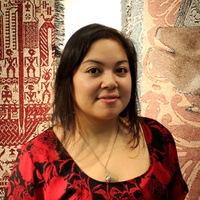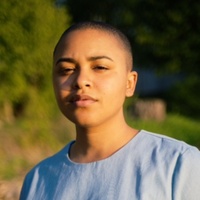Confessions of a failed artist
Prelude
Roderick (“Roddy”) Schrock manages the functional capacities of Eyebeam’s direct artist support, and guides its focus on supporting work that aims to realign societal relationships to emergent technologies. He has been an active practitioner in digital and sound art, having lived and worked on three continents. He now lives in Brooklyn with his partner, the writer Joon Oluchi Lee, and their dog Nella.
Editor’s note: This essay is the second piece to be published as part of Conditions, a new series exploring how various forces affect our ability to live fulfilling, creative lives.
Conversation
Confessions of a failed artist
As told to Roderick Schrock, 1774 words.
In the summer of 2000 I was living in Tokyo, trying to figure out how to make a life as a musician. It was extremely hot and humid that summer, but I didn’t really notice because I was totally consumed with the excitement and novelty of making music with computers.
It seems a bit strange in retrospect that there was a time when you couldn’t fire up MaxMSP or SuperCollider and, with dangerously little coding knowledge, create sounds and visuals that felt fresh, empowering, and a little scary. There is a long history of machinic music making, of course, but for me at that time, the ease of experimentation unlocked by cracked software was something new. At that rather young age, the sensation of endless firsts—from living abroad to the sheer exuberance of life in a mega-city—was enough to make the hot weather the last thing on my mind.
That year my days were spent visiting experimental CD shops with names like “Disk Union” and “Los Apson,” nestled under rickety train overpasses in the sometimes seedier parts of the city. Nights were filled with small-room shows, trying out my latest home-brew software concoctions, each of which was intended to rip up the sonic spectrum as we knew it. I had found my way, and kicking off the mud of my southern upbringing, I hoped to become the musician I thought I was meant to be.
Around that time, I had the privilege of meeting with famed composer and pianist Yuji Takahashi through the introduction of a friend. I had seen his ensemble perform at a venue called Deluxe, and to this day remember it as one of the most intricate sound performances I have ever experienced—full of fluidity and improvisation inside a highly structured frame. I’m still not sure why he agreed to meet with me, but it felt revelatory to have the opportunity.
As I sat in his studio, drinking tea as brilliant sun streamed in, he patiently reviewed my untidy scores and even listened to some of my recordings. I remember regretting showing him so many things that still felt unfinished, and found myself making repeated justifications for the works’ lack of focus and overall regrettable naiveté. I remember at one point he chided me for my lack of urgency, and for seemingly wasting too much time. I distinctly remember laughing as he said this, telling him, “I have plenty of time, I’ll get more serious about it later.” After all, I was just getting started (in my defense, I was about twenty years old).
Unsurprisingly, there were no follow-up meetings or lessons. Four summers later, having tried somewhat unsuccessfully to not ignore Takahashi-sensei’s advice, I was now in Amsterdam teaching a week-long course in electronic music at a European digital music studio. With a lot of experience playing unpaid gigs in nooks and crannies of experimental music venues under my belt, a few indie-released CD’s, and no steady income, I was quickly realizing how materially challenging a career as an artist could be.
At that point, I was still psychologically sustained by my creative practice, and fully committed to the work. But staring down the inevitability of my thirties while lacking anything approaching a path to a sustainable career—or even knowing where I was going to live from month to month—I was deeply confused about how to make a life.
As I rode out my career crisis, in some last-ditch effort shuttling between Amsterdam, Tokyo, and San Francisco, I began to think more and more about what “being an artist” means. In all of my studies, there was no discussion of what maintaining a creative life requires. Add to this the simultaneous dissolving of many ‘90s independent music labels due to Napster, along with the collapse of the music industry as a whole, and the outlook was bleak, to say the least. I halfheartedly began trying to find sound-effects jobs within the video game sector, but even that felt both demoralizing and surprisingly challenging.
Over the ensuing years, I continued to look for ways to bring it all together—to figure out how to be, simultaneously, an artist and a person surviving under capitalism. And, to do this in a way that didn’t involve random jobs, temporary music opportunities, and adjunct academic positions which typically paid worse than minimum wage. Despite my best efforts, the larger puzzle of how to live kept falling apart; necessary pieces were still missing.
The single most crucial thing that I didn’t know then was that the problem wasn’t simply about me finding my next gig—it was about thinking clearly and expansively about how to create conditions under which I could allow myself to be creative. When this revelation occurred to me, I realized that this was something I was very motivated to do: create better conditions not only for myself, but for all artists looking to grow their practices, engage audiences, and live a sustainable life.
Over time, I saw that I could be creative and help other artists improve their own conditions for creativity by aligning myself with institutions that shared this mission. After deciding to put my roots down more firmly in the United States once again, I happily found a number of incredibly valuable and generous organizations that were dedicated to promoting artistic growth, aiming to provide direct support, encourage field-building, and create sustainable conditions through professional development.
In Silicon Valley, I helped build what at that time was known as a “new media” department in a local arts non-profit. Simultaneously, I was working with a number of San Francisco-based venues in co-developing programs featuring artists I strongly believed in. All the while, I would host quarterly salon gatherings in my apartment, featuring emerging artists who were traveling through town or already working in the city. To this day, I am close to so many people from this time. The independent and institutionally collaborative work I did then opened up so many new ways for me to understand my own creative practice, both as an artist and as an arts advocate—and the ways in which both practices can nourish each other.
Anyone who has worked for an arts organization knows that it requires all of the hustle and imagination of a creative practice to conjure into existence things that didn’t exist before. My work now, these many years later, is as the executive director of a non-profit artist support organization called Eyebeam. I’ve now been in this role a little over three years, and there is rarely a day that goes by in which I do not utilize my art-making muscles in ways that I could have only imagined when I was younger.
As I reflect on my evolution as a creative person, it occurs to me that those who are able to sustain a creative life have a commonality of conditions. Probably the most important is a connection to a well-developed community. I don’t mean the superficial, astro-turf version, but community in which people are in deeply rooted relationships with their peers. It often takes years to develop this around one’s practice—years of putting one’s body into the spaces of peers and rivals, for better or worse. The binding agent here is a focus on the practice itself, along with a belief in its potentials.
I couldn’t have sustained my artist’s life for nearly as long as I did without the community that I was able to plug into. Many of the people I met while trying to make it as an artist are still close friends to this day—people who I ask advice of and make introductions to. I didn’t know it at the time, but those relationships were what allowed us all to grow, each in our own varied ways.
Another revelation worth mentioning—which I guess is a little cliché now, but still very true—is how important it is to make room for failure. It is impossible to make something brilliant and new if there is no space for also making things that are radically unsuccessful. A creative project of any kind requires a full runway for take-off, unfettered by the doubt or hesitation caused by fear of failure. Typically, it is only after a thing has fully been realized that you can judge its value. A space to do exactly that is key to anyone’s growth as a creative individual. After all, no one is going to die from bad art.
Over the last decade, I have come to terms with the fact that in many ways I am a failed artist. I certainly haven’t achieved the level of success I aspired to in music. I haven’t collaborated with my idols, haven’t had wide distribution of my work, and haven’t had my work fill the spaces I dreamed of when I was younger. But if I widen the lens a little bit, I can see that in my current work, I am exactly the same person as I was when I was trying to be a musician—with the same needs and hopes—and that I am more fulfilled creatively than ever before. In my own way, failure showed me a path, and that allowed me to broaden my understanding of my own creative life.
At the end of the day, what do artists do? They hustle. They respond. They nurture feral imaginations. They harness the best of what a strong ego can provide to conjure energy when others are spent. The good ones are cultural scent-hounds, sniffing out fecund futurities. They’re critical, conceptual stress-testers. In other words, deeply creative people, at least those I have known, are human. Maybe just a little more so. I still feel this way.
| Symbol: | Weather: | Music: | Location: | Emotion: |
 |
Unseasonably chilly and rather dark | Arvo Part, Emmylou Harris (in headphones) | Numerous very noisy cafes | Relieved in some ways to be verbalizing something that is helpful for me to be explicit about, and hopeful that it can be interesting or maybe even useful to someone else. |
- Name
- Roderick Schrock
- Vocation
- Writer, musician, Director of Eyebeam

Conditions report at the time of writing this essay
Pagination



